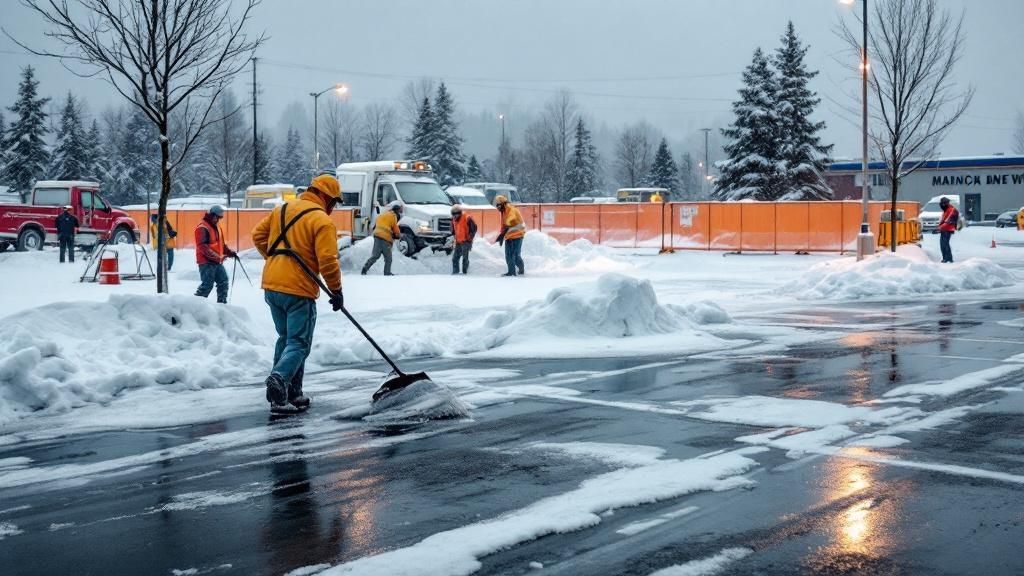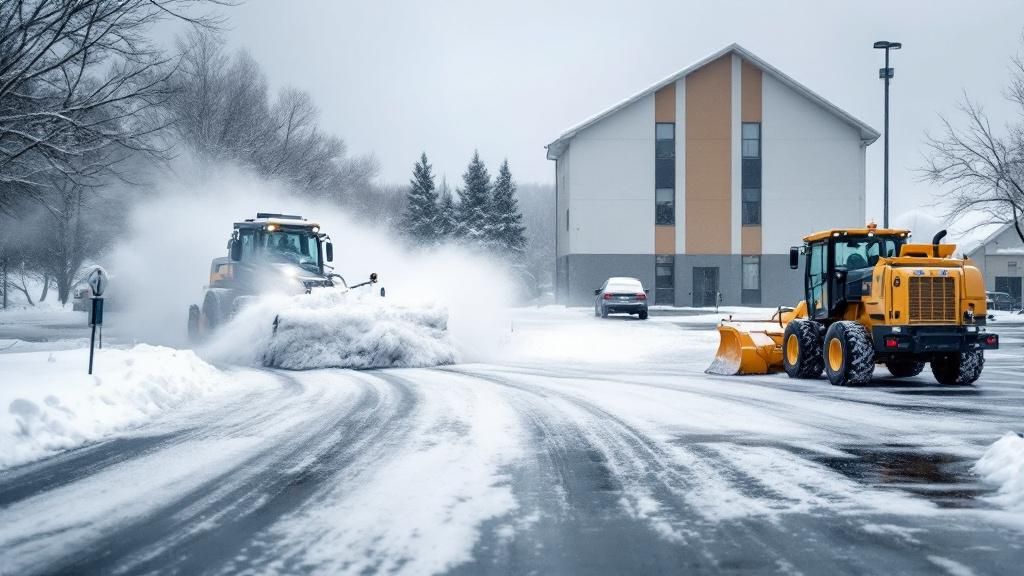
Snow and Ice Management for Commercial Properties in Anchorage
-
Snow and ice pose significant safety and liability risks for Anchorage commercial property owners.
-
Proactive, site-specific snow removal planning reduces costs and operational disruption.
-
Proper snow management prevents pavement damage from freeze-thaw cycles.
-
Delays in snow removal can create hazardous refreezing zones and legal liabilities.
-
Local professionals understand the timing, terrain, and snow behavior unique to Anchorage winters.
In Anchorage, where winters can deliver snow totals of over 70 inches annually, commercial property owners must treat snow and ice management as more than just routine maintenance—it’s risk mitigation. From walkways and loading docks to expansive parking lots, untreated snow and black ice can trigger serious accidents and expensive damage. This guide unpacks the essentials of managing snow and ice effectively across Anchorage commercial properties.
Snow and Ice: A Daily Risk to Safety and Structure
Commercial properties experience high foot and vehicle traffic, which turns accumulated snow into compacted, slippery layers. The consequences are immediate and wide-reaching:
-
Increased risk of slip-and-fall accidents for employees and visitors
-
Vehicle damage from hidden potholes or frozen surfaces
-
Drainage system blockages and roof leaks from unremoved snow
-
Long-term asphalt damage from freeze-thaw cycles
These outcomes are not just costly—they’re avoidable with strategic snow management that addresses both surface and sub-surface threats.
Why Quick Response is Non-Negotiable
Delaying snow removal increases the chances of hard-pack formation and nighttime refreezing, which make conditions more dangerous and harder to treat. Anchorage’s freeze-melt cycles contribute to:
-
Overnight formation of black ice
-
Compaction that damages paving
-
Overflow and icy buildup in sloped lots or poorly graded spaces
Pre-treatment with salt brine and timely snow clearing helps break this cycle. Efficient contractors often monitor forecasts and act before storms even hit, deploying crews and equipment at the right time—not just after snow begins to fall.

Commercial-Specific Challenges in Anchorage
Snow removal for retail centers, office parks, and industrial properties is more complex than residential work. Unique challenges include:
-
Navigating curbs, medians, bollards, and cart returns
-
Ensuring visibility for signage and fire lanes
-
Maintaining 24/7 access for emergency and delivery vehicles
-
Addressing shaded areas that refreeze during daylight hours
This calls for customized plowing paths, snow staging zones, and coordination with your tenants or staff to manage high-traffic windows.
Strategic Solutions That Actually Work
Overcomplicating snow removal with high-tech gadgets can lead to inefficiencies. Anchorage’s best solutions are practical and proven:
-
Use of angled plows with rubber blades to protect asphalt
-
Designated snow piling areas to avoid obstructing visibility or runoff paths
-
Layered salting and sanding for traction and melting across variable surfaces
-
Routine inspections to check drainage flow, icing, and walkable surfaces
Even basic vegetation maintenance—like trimming back trees near parking lots—can reduce snow buildup and ice formation caused by shading.
A Look at Sub-Base and Surface Durability
Pavement damage from snow and ice isn’t just from salt. Improper sub-base preparation can make asphalt or concrete vulnerable to heaving, cracking, and pothole formation.
Good commercial snow management includes preventive infrastructure support:
-
Gravel or stabilized base layers under pavement
-
Crack sealing in fall before freeze sets in
-
Avoiding snow piles that trap meltwater over joints
Incorporating these practices reduces the frequency of costly resurfacing projects.

Why Anchorage Property Owners Trust Local Pros
Professional snow and ice management companies in Anchorage, like Titan, understand how to match the terrain, building layout, and usage of a site to a practical, cost-effective snow plan. From office complexes to retail parking lots, local teams bring the tools and timing that generic contractors often miss.
Titan has decades of experience in maintaining winter-ready commercial sites across Anchorage, Eagle River, and the Mat-Su Valley—handling everything from plowing to de-icing with a focus on long-term surface protection and liability reduction.
FAQs
How much snow does Anchorage typically get in winter?
Anchorage averages over 70 inches of snow annually, often arriving in extended storms or back-to-back events.
What are the most common mistakes in parking lot snow removal?
Late response, uneven salt distribution, and poor snow pile placement that blocks sightlines or causes refreezing are top issues.
Are there alternatives to salt for ice control?
Yes—sanded blends and liquid brine mixes are often used to reduce salt damage while improving traction.
What’s the biggest risk of delaying snow removal?
Legal liability from slip-and-fall injuries, compounded by costly surface damage from refreezing.